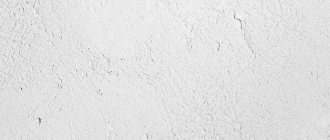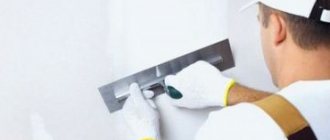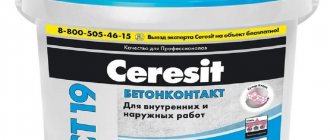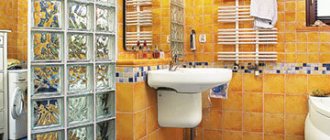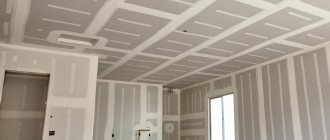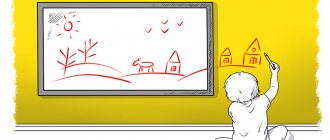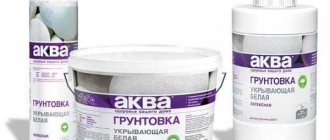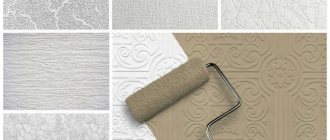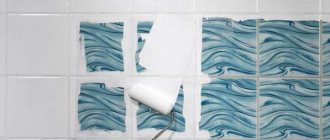What mixtures exist, how to make the right choice (what is better to choose)
To make putty for wet rooms, natural and synthetic components are used, as well as additives that improve the elasticity and strength of the material.
Types of polymer compositions
The polymer mixtures contain high-tech components. The applied layer polymerizes when exposed to air.
There are these types of materials:
- Acrylic
. They tolerate temperature changes and moisture well. Acrylic-based compositions can be universal or specialized. This putty does not interfere with air exchange, therefore reducing the risk of mold and mildew. It is environmentally friendly and odorless. The mass hardens quickly, so you should not knead a large amount of material. Apply it in a layer of minimal thickness.
- Latex
. The main component is rubber resin. Such mixtures are breathable, have high strength, and at the same time they acquire a glossy shine. However, you should not use them in rooms with high humidity if the composition does not contain hydrophobic additives. The material is convenient to work with, so it is often used by inexperienced craftsmen. Use a latex mixture to level the walls, which continue to shrink.
- Policeman
. The main component of the substance is synthetic cement. This is a universal finishing material and can be used to line walls in the kitchen and bathroom. The composition seals deep cracks. The maximum layer thickness is 30 cm.
Moisture-resistant putty has a high level of adhesion. To level the walls in the bathroom, you can even use façade putty, as it is resistant to any negative influences.
Gypsum putty
When painting a room white or pastel, it is better to use a gypsum mixture. It withstands moisture well, but is afraid of temperature changes. The advantage of this material is minimal consumption. It hardens quickly, but no cracks form. Use gypsum putty for the bathroom before painting. However, it must contain Portland cement. The still frozen layer has good vapor permeability.
The gypsum-based material is environmentally friendly and does not contain toxic components. It can be applied to different substrates: concrete, plasterboard, brick.
Moisture-resistant cement-based putties
Cement compositions have high strength. They strengthen the concrete surface. The main component of the mixture is Portland cement. The material is affordable. It is capable of leveling out level differences of up to 1.5 cm. The disadvantage is the gray or yellow color of the finished layer, which makes it unacceptable for finishing with light paints. This waterproof putty also has a grainy structure, so it will not be possible to achieve complete smoothness.
To reduce paint consumption, you can use a pigmented leveling solution.
Types of putty for wet rooms
The construction market is replete with putty materials that have different properties and composition. Various subsequent types of finishing are also used. Regardless of this, putty for a bathroom or other heavily humidified room should be:
- moisture-resistant so that the created coating does not collapse (do not get wet) during operation from direct exposure to water or its vapor;
- durable (minimum 20 years);
- resistant to temperature fluctuations: does not shrink or expand during changes.
Facade putty
Facade varieties meet all the stated requirements. The photo below shows one of many brands of such material.
In addition to these basic criteria, when choosing a material, you should take into account the method of further decorative finishing. For example, the formed coating for painting should not be subject to shrinkage, so putty is selected with this property.
Waterproof putty is divided into the following types according to its intended purpose:
- finishing, used for final finishing of surfaces;
- leveling (starting), designed to hide defects (holes, minor irregularities);
- universal, which combines the functions of the first two types.
According to readiness for use (release form), the putty is divided into:
- dry mixtures that need to be diluted with water before use;
- ready-made solutions.
Products suitable for use in wet conditions must be labeled accordingly (indication of moisture resistance).
Products are produced in various packaging: plastic buckets and bags. The container helps preserve the original properties of the material for a long time. It is easier to work with ready-made mixtures, but they also cost more than dry mixtures. When purchasing, be sure to pay attention to the expiration date of the material so as not to purchase an expired product of poor quality. This will allow you to get an excellent result if you follow the application technology.
Advantages and disadvantages of waterproof putty
This mixture is used to level walls in the bathroom, because it has the following advantages:
- high level of plasticity;
- short hardening time;
- no need for a special tool for applying the composition;
- strength;
- resistance to the development of fungus and mold.
Bathroom putty extends the life of decorative finishes and prevents peeling. The disadvantage of the mixture is its high cost. When grinding the surface, it is necessary to wear safety glasses and a respirator, as fine dust is generated.
Subtleties of choice
When purchasing a waterproof compound for putty, take into account the following features:
- Resistance to mechanical damage and temperature changes. This quality is provided by plasticizers that protect the base from expansion and contraction of the finishing material.
- The long service life of putty for bathroom walls is 12-20 years.
- Required technical characteristics. If the composition is hydrophobic, then apply it in several layers.
- Resistance to temperature changes.
- Material type. If the mixture contains coarse river sand, it is used to level concrete or brick bases. If the walls are smooth, a finishing putty containing small components, gypsum or Portland cement is suitable for the job.
If you use a cement-based material, you need to remember that when exposed to moisture it becomes stronger.
Putty: preparation and sequence of actions
Dismantling and checking the old coating. This stage is necessary to check the condition of surfaces, remove pockets of mold, rot and fill cracks and voids. Checking the operation of the ventilation system. If malfunctions are detected, they must be eliminated before repairs begin.
Determination of deviations of corners, walls, connections. Slopes of more than 5 mm are eliminated with plaster. Cleaning walls from large waves and irregularities after plastering. It is necessary to de-energize the wiring, remove switches, sockets, cable ducts and other electrical equipment.
A primer is applied and time is waited for the surface to dry. Putty material is being prepared. It is recommended to prepare it in small quantities so that it has time to work out before it dries.
Next, the walls in the bathroom begin to be puttied. The process is structured as follows: take the mixture with a small spatula, transfer it to a large spatula, and use it on the wall. A convenient angle of inclination of the tool is selected. The main goal of the work is to level the entire surface. Using a pre-prepared level, the smoothness of the surface is controlled. It is processed with sandpaper or surface grinding equipment. This stage is very dusty, so it is better to vacuum the bathroom.
Use an angle spatula to smooth out transitions and connections in the corners of the room. Here it is important to maintain the thickness of the coating layer. Violation of technology can lead to cracks and divergence of seams. The corners seem to be rolled up with a roller. When performing work, specialists select a serpyanka mesh, which simplifies the leveling work. It is good for connecting the seams between the panels. Work on the ceiling does not have any special requirements, it is completely similar. Only the quality of the paint can differ. It should be more moisture and heat resistant. It is to the ceiling that hot air and steam rise. Vapor-proof paint is an ideal option for renovation.
What tools are needed?
The following tools are used for work:
- bucket for mixing putty mixture;
- a device for applying a substance to a trowel;
- a drill with a special attachment or a construction mixer;
- spatulas of different sizes;
- rule for checking the vertical level of the base after leveling;
- sanding machine or sandpaper of varying degrees of grain;
- roller or brushes for applying primer;
- metal brush;
- pencil, building level, square, plumb line, measuring tape.
Masking tape is used to protect adjacent areas.
Technology of working with material
The mixture should be applied to the surface only after it has been thoroughly prepared. The work is not particularly difficult, does not require the use of specific tools and equipment, and can be completed independently without the involvement of third parties. The only requirement is to do everything carefully, carefully and not rush.
- As a tool, you need to prepare: containers for filling with water, solution and primer;
- a hammer drill or electric drill with whisks for mixing putty;
- level, brushes and roller;
- metal brush for rough cleaning;
- a block of fine-grained sandpaper for sanding;
- stepladder
- take the necessary measurements and calculate the area of the treated areas for painting;
Advice. Don’t forget to add about 10 percent of the reserve to the calculated volume.
- clean the surface of dirt, remove old coating and sagging;
Advice. Preparatory work is an important step in the process of filling wet rooms. The reliability of the putty layer and the appearance of the finishing along with decorative elements depend on how well they are made.
Preparation of the solution
The mixture is created on the basis of dry powdered putties.
- The required amount of powder is poured into the container.
- Adding water little by little, mix the composition. To do this, use a hammer drill or a mixer with attachments.
- After complete mixing, leave the mixture for 10 - 15 minutes. The end result should be a paste-like mixture.
- Before use, stir the solution again.
Important! When mixing the solution, it is necessary to take into account that a large amount of the prepared mixture may simply harden while the work is being done on the surface. Therefore, it is recommended to prepare the solution in small portions.
Application
A special feature of work involving the use of putty material is the lack of special equipment and tools. You only need to prepare spatulas of different sizes. There are no specific types; it all depends on the skills and preferences of the employee. The putty must be applied on top of the primer layer, level it and achieve an ideal surface.
Surface preparation
Putty for wet rooms is used only after cleaning and preparing the base.
To do this, perform the following work:
- assess damage to the walls, inspect them for the presence of mold, flaking fragments, and dirt;
- wash off dust and dirt from the surface;
- if necessary, remove the old decorative coating: use a mechanical or thermal method (to remove paint);
- before puttying, uneven spots and cracks are covered with a repair compound (first, the cracks are widened, cleaned and degreased);
- if the differences in level are too large, then preliminary plastering of the base is required;
- Before applying bathroom putty, the surface of the walls is thoroughly dried (you can use a hair dryer).
The mixture is placed on a pre-primed base. The liquid is applied with a roller or spray. If there are sagging or protruding fragments of reinforcement on the site, they are removed.
Most compositions for wet rooms are resistant to mold and mildew, but the surface of the base can be additionally treated with an antiseptic.
Offers from manufacturers
You may find the following waterproof putties in hardware stores:
- «Weber Vetonit»:
| Parameter | Description |
| Country of manufacture | Russia |
| Suitable materials for processing |
|
| Color | White |
| Weight | 25 kg |
| Application method | Manual |
| Approximate consumption with a millimeter layer of application | 1200 g per square meter |
| Possible layer thickness | 1-3 mm |
| Curing period | A week |
| Base type | Cement |
| Price | 540 rubles |
"Weber Vetonit" is excellent not only for interior but also for exterior work
- «Shitrock»:
| Parameter | Description |
| Country of manufacture | USA |
| Suitable materials for processing |
|
| Color | White |
| Weight | 28 kg |
| Application method | Manual |
| Curing period | A week |
| Base type | Polymers |
| Price | 1500 rubles |
Shitrok has excellent contact with almost all possible types of substrates
- «GLIMS Styro Prime»:
| Parameter | Description |
| Country of manufacture | Russia |
| Suitable materials for processing |
|
| Weight | 20 kg |
| Application method | Machine |
| Approximate consumption with a millimeter layer of application | 1500 g per square meter |
| Possible layer thickness | 2-20 mm |
| Base type | Cement |
| Price | 600 rubles |
"GLIMS Styro Prime" is used to reinforce insulation layers and protect them from excessive moisture
- «GLIMS Finish-R»:
| Parameter | Description |
| Country of manufacture | Russia |
| Suitable materials for processing |
|
| Color | White |
| Weight | 5 kg |
| Approximate consumption with a millimeter layer of application | 1200 g per square meter |
| Possible layer thickness | 0.1-10 mm |
| Application method | Manual |
| Curing period | Day |
| Base type | Cement |
| Price | 225 rubles |
“GLIMS Finish-R” due to its high plasticity can be applied in a layer thickness from 0.1 to 10 mm
- «Prospectors Basic Gray»:
| Parameter | Description |
| Country of manufacture | Russia |
| Suitable materials for processing |
|
| Color | Grey |
| Weight | 20 kg |
| Approximate consumption with a millimeter layer of application | 1000 g per square meter |
| Possible layer thickness | 0.8-8 mm |
| Application method | Manual |
| Curing period | Day |
| Base type | Cement |
| Price | 230 rubles |
“Prospectors Basic Gray” is one of the cheapest representatives of waterproof putties
Carrying out puttying
Moisture-resistant bath putty should be diluted in small quantities. More often the material is applied in 2 layers. In this case, the previous coating must be completely dry before the next one.
Bathroom putty for painting
After treating the walls with primer, a gypsum-cement composition is applied to them: it is better suited for painting. Experts recommend using putty and finishing material based on the same component.
The technology provides for the following types of work:
- Applying the mixture. They do it overlapping. The thickness of the coating often does not exceed 2-4 mm. This can be achieved by using the correct pressure on the tool. The solution is applied in several layers.
- Drying the walls. To do this, protect the room from drafts or direct sunlight on the surface (if there is a window in the bathroom). Artificial drying using a heat gun or hair dryer. The average drying period for the putty is 12 hours, but further work is best done every other day.
- Surface grinding. A jointer with coarse sandpaper attached to it removes the sagging. The procedure is carried out in bright light.
After rough sanding, a thin layer of finishing putty is applied to the base. After it has completely dried, the surface is treated with fine-grained sandpaper. To achieve a mirror effect of paint, the walls are polished.
Puttying wooden surfaces in the bathroom
For treating wood flooring, it is better to use universal acrylate-based compounds. They are well absorbed into the texture of the base.
The following mixtures are used for work:
- latex;
- hydrophobic;
- oil-glue;
- polymer putty.
The maximum layer thickness is 1.5-2 mm. After the mixture has dried, the surface is checked under a bright light for defects or unevenness. Lastly, the base is treated with fine-grained sandpaper.
Types of polymer compositions
Polymer compositions are:
- acrylic: recommended for initial (rough) and final (finish) finishing. They are characterized by a high degree of plasticity and the ability to fill unevenness. The solution is odorless, working with it does not cause allergies;
- latex: give excellent results - a perfectly mirror surface. Can be combined with any building materials, universal in action, quality and result.
Polymer putty
Tips for saving mixture when plastering walls
Many beginners are interested in which putty to choose for the bathroom. You need to understand that a quality product is not cheap.
But you can save the mixture if you follow the following expert advice:
- pre-calculate the amount of material;
- reduce layer thickness;
- Level the walls with plaster, and then apply putty.
Wall decoration in the bathroom is most often exposed to moisture and temperature changes, so it must be protected. This can be done using moisture-resistant putty. In order for the cladding to last longer, it is better not to skimp on leveling the base.
Recommendations from experts
To properly apply putty under tiles or paint in the bathroom, there are a few simple rules:
- If there are unevenness and cracks on the walls, then it is better to reinforce them with a special mesh.
- The layers of solution should not be too thick, especially if there are several of them.
- Using heat guns to dry faster can be dangerous and may cause the coating to crack.
- In a bathhouse or bathroom, you can use mixtures for facades.
- When sanding the coating for paint, do it carefully so that the wall does not have noticeable defects after painting.
- The moisture-resistant coating will last a long time if you do not skimp on layers.
Moisture-resistant putty does not require special skills in handling it
Ready-made waterproof putty will not require much effort to apply, even for those new to renovation. You must follow the instructions on the packaging and follow the application technology. In this case, the bathroom or kitchen will be perfectly renovated, and the coating will last for many years.
Was this information useful to you? Share in the comments!
